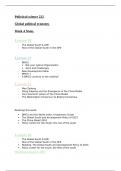BS3540
Cancer
Lecture 3: Tumour suppress genes
Cell fusion experiment:
- Because viral and cellular oncogenes can overrule cellular
processes like normal proliferation, they induce dominant
phenotype.
- Normal cells carry genes that constrain or suppress their
proliferation (tumour suppressor genes (TSG).
- Once these growth-suppressing genes are lost the proliferation of
cancer cells is no longer held back
- Recessive: the function of both copies ought to be lost
- Somatic culture cells; end up fusing (two diploid cells)
- Mutations have a certain probability; 1 in a million
Likelihood/cell generation
Mutation one copy: 106
Both copies: 1012
The retinoblastoma:
- In the eye
- 1:20,000 case
- Familial cancer
- The inheritance of mutant tumour suppressors greatly increases
cancer risk; GATEKEEPERS. RETINOBLASTOMA (RB)
- Not all familiar cancer is due to mutations in tumour suppressors,
another large class is in genome maintenance: CARETAKERS p53
- Bilateral = always inherited from parents; will pick up
mutation on the second chromosome by first somatic
mutation
- Uni lateral = not familial. Pick up one mutation then during
a lifetime, pick up a second mutation; so is chance based
Mitotic recombination:
, - Loss of RB heterozygosity after mitotic recombination
- Frequency of mitotic recombination 10-5-10-4
- Endogamy (breeding within a group) increases homologue regions and mitotic
recombination
- Occurs during meiosis and in somatic cells
- Exchange between sections of the chromosome, then segregate into separate chromosome
arms
Gene conversion:
- More frequent than mitotic
recombination
- Exchange of genetic material between
homologous chromosomes
- During DNA synthesis
- Borrow DNA from another
chromosome
DNA methylation: Epigenetic mechanism for controlling gene expression:
- Methylated CpGs
enable recruitment of
histone deacetylase
(HDAC) that removes
acetyl modifications
from core histones,
alters chromatin
structure to a more
closed-repressed
heterochromatin form
that blocks transcription.
- Inappropriate methylation in promoter regions might silence gene copies.
- Inappropriate methylation provides an important mechanism of shutting down tumour-
suppressor genes
- Don’t necessarily need a mutation and silences the other copy
The cell cycle clock:
- Master governor that integrates a variety of
incoming signals and decides whether the cell
should enter the cell cycle or retreat into non-
proliferating state (quiescent or post mitotic).
- After this decision has been made in governs the
circuitry of program that enable DNA synthesis in
S-phase and chromosome segregation in mitosis
leading to the formation of two daughter cells
after cytokinesis.
- Cell growth + cell division = proliferation
Cancer
Lecture 3: Tumour suppress genes
Cell fusion experiment:
- Because viral and cellular oncogenes can overrule cellular
processes like normal proliferation, they induce dominant
phenotype.
- Normal cells carry genes that constrain or suppress their
proliferation (tumour suppressor genes (TSG).
- Once these growth-suppressing genes are lost the proliferation of
cancer cells is no longer held back
- Recessive: the function of both copies ought to be lost
- Somatic culture cells; end up fusing (two diploid cells)
- Mutations have a certain probability; 1 in a million
Likelihood/cell generation
Mutation one copy: 106
Both copies: 1012
The retinoblastoma:
- In the eye
- 1:20,000 case
- Familial cancer
- The inheritance of mutant tumour suppressors greatly increases
cancer risk; GATEKEEPERS. RETINOBLASTOMA (RB)
- Not all familiar cancer is due to mutations in tumour suppressors,
another large class is in genome maintenance: CARETAKERS p53
- Bilateral = always inherited from parents; will pick up
mutation on the second chromosome by first somatic
mutation
- Uni lateral = not familial. Pick up one mutation then during
a lifetime, pick up a second mutation; so is chance based
Mitotic recombination:
, - Loss of RB heterozygosity after mitotic recombination
- Frequency of mitotic recombination 10-5-10-4
- Endogamy (breeding within a group) increases homologue regions and mitotic
recombination
- Occurs during meiosis and in somatic cells
- Exchange between sections of the chromosome, then segregate into separate chromosome
arms
Gene conversion:
- More frequent than mitotic
recombination
- Exchange of genetic material between
homologous chromosomes
- During DNA synthesis
- Borrow DNA from another
chromosome
DNA methylation: Epigenetic mechanism for controlling gene expression:
- Methylated CpGs
enable recruitment of
histone deacetylase
(HDAC) that removes
acetyl modifications
from core histones,
alters chromatin
structure to a more
closed-repressed
heterochromatin form
that blocks transcription.
- Inappropriate methylation in promoter regions might silence gene copies.
- Inappropriate methylation provides an important mechanism of shutting down tumour-
suppressor genes
- Don’t necessarily need a mutation and silences the other copy
The cell cycle clock:
- Master governor that integrates a variety of
incoming signals and decides whether the cell
should enter the cell cycle or retreat into non-
proliferating state (quiescent or post mitotic).
- After this decision has been made in governs the
circuitry of program that enable DNA synthesis in
S-phase and chromosome segregation in mitosis
leading to the formation of two daughter cells
after cytokinesis.
- Cell growth + cell division = proliferation










